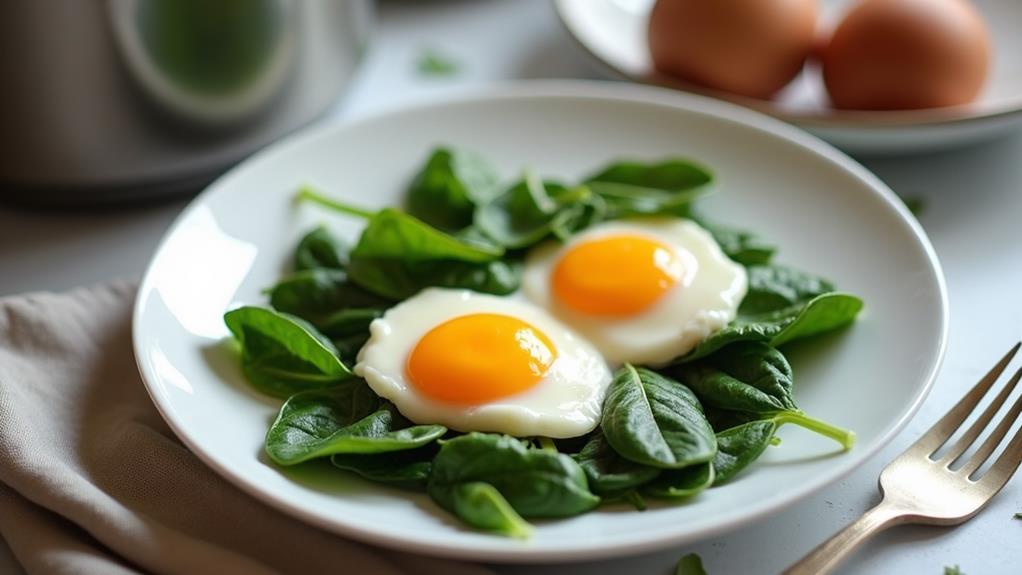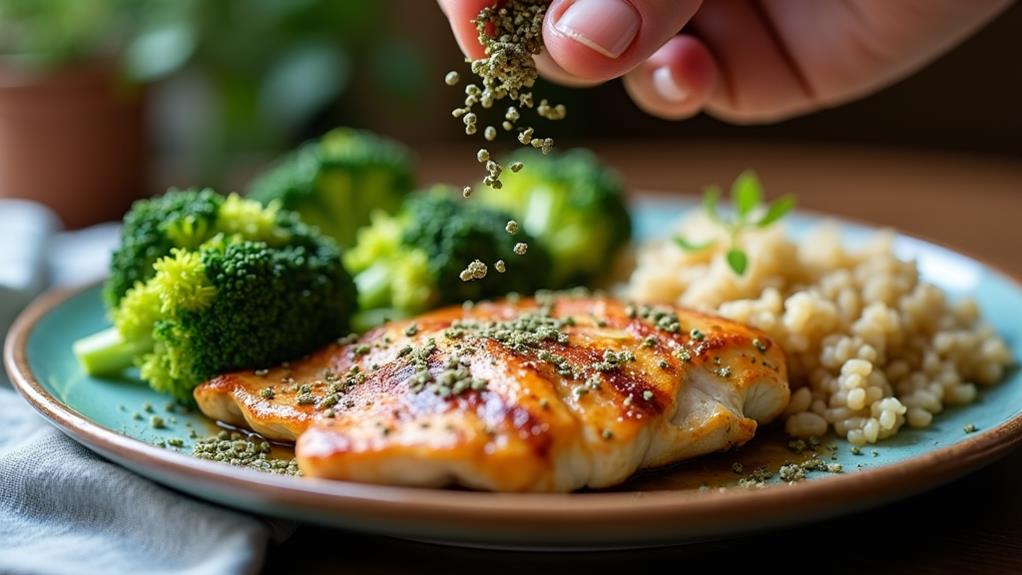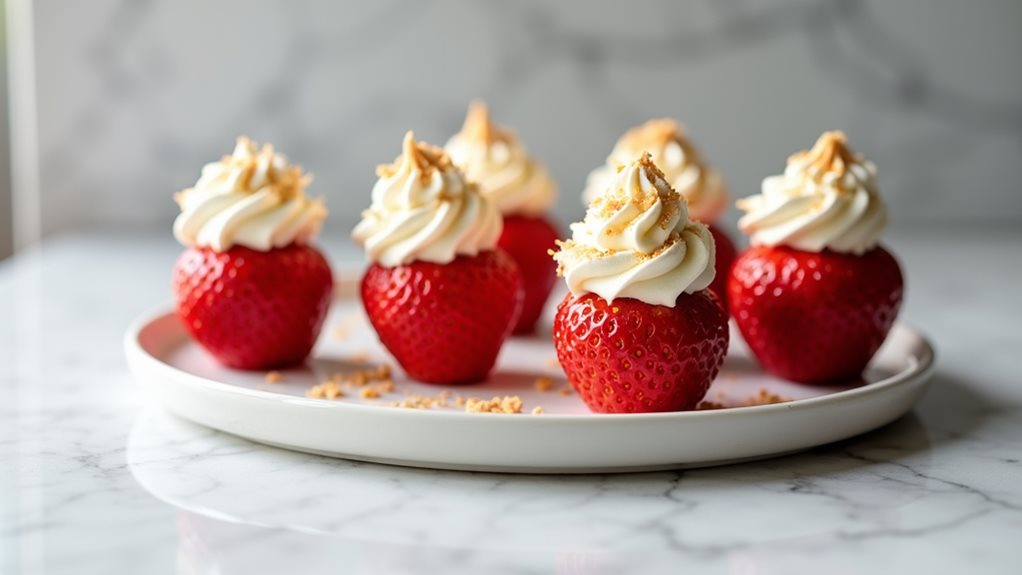To master perfectly poached eggs, you'll need to understand the science and techniques behind this culinary art. Start by maintaining water temperature between 180°F to 190°F and creating a gentle whirlpool in the water. Use fresh eggs and add a splash of vinegar to help the whites coagulate. Time your eggs carefully, aiming for about 3 minutes for a set white and runny yolk. Invest in essential tools like a wide skillet, slotted spoon, and digital thermometer for consistent results. With practice, you'll elevate your breakfast game and unlock a world of global poached egg recipes to explore.
The Science Behind Egg Poaching
Egg poaching is a delicate culinary process that relies on precise temperature control and timing. To master this technique, you'll need to understand the science behind egg chemistry and poaching temperatures.
When you submerge an egg in water, the heat causes proteins to denature and coagulate, transforming the liquid egg white into a solid form. The ideal poaching temperature range is between 160°F and 180°F (71°C to 82°C). At these temperatures, the egg whites will set while the yolk remains creamy and liquid.
To achieve perfectly poached eggs, you'll want to create a gentle whirlpool in the water before adding the egg. This motion helps the egg white wrap around the yolk, creating that classic, compact shape.
Adding a splash of vinegar to the water lowers its pH, which speeds up protein coagulation and helps prevent the egg white from dispersing. By understanding these scientific principles, you can innovate and experiment with different poaching methods, such as using sous vide techniques or even microwave poaching, to achieve consistent results every time.
Essential Tools for Perfect Poaching
To achieve perfectly poached eggs, you'll need to start with the right equipment.
Choosing an appropriate pan is crucial; opt for a wide, shallow skillet or a dedicated egg-poaching pan that allows for easy maneuvering and even heat distribution.
You'll also want to invest in proper egg-poaching tools, such as silicone poaching cups or a slotted spoon, which will help you create consistently shaped eggs and remove them from the water with ease.
Choosing the Right Pan
Success in poaching eggs starts with selecting the right pan. You'll want to consider two crucial factors: pan material and pan size.
Opt for a stainless steel or non-stick pan, as these materials distribute heat evenly and prevent eggs from sticking. Avoid aluminum pans, which can react with acidic ingredients and alter the taste of your eggs.
When it comes to pan size, choose one that's at least 3 inches deep and wide enough to accommodate multiple eggs without crowding. A 10-inch pan is ideal for poaching 2-4 eggs simultaneously. The depth is crucial, as it allows enough water for the eggs to float freely and form their signature oval shape.
For those seeking innovation, consider a dedicated egg-poaching pan with removable cups. These specialized pans offer precision and consistency, ensuring perfectly shaped poached eggs every time.
However, mastering the traditional method with a standard pan will give you more versatility in your culinary pursuits. Remember, the right pan is your foundation for achieving that elusive, restaurant-quality poached egg at home.
Proper Egg-Poaching Tools
Along with the right pan, a few essential tools can elevate your egg-poaching game. To master various poaching methods and accommodate different egg varieties, you'll need:
- A slotted spoon for gently lifting poached eggs
- A timer to ensure precise cooking
- Small bowls or ramekins for cracking eggs before poaching
Investing in a spider skimmer can revolutionize your poaching technique. This tool allows you to lower eggs into the water smoothly, reducing the risk of spreading whites.
For those seeking innovation, consider silicone egg poaching pods. These flexible cups cradle the eggs, creating perfectly shaped results every time.
Don't overlook the importance of a whisk. Creating a gentle vortex in the water helps wrap the egg whites around the yolk, resulting in a more cohesive poached egg.
If you're dealing with farm-fresh eggs, which have firmer whites, a fine-mesh strainer can help remove excess liquid before poaching.
For precision in water temperature, a digital thermometer is invaluable. It ensures your water maintains the ideal 180-190°F range, crucial for achieving that coveted runny yolk surrounded by fully set whites.
Selecting the Freshest Eggs
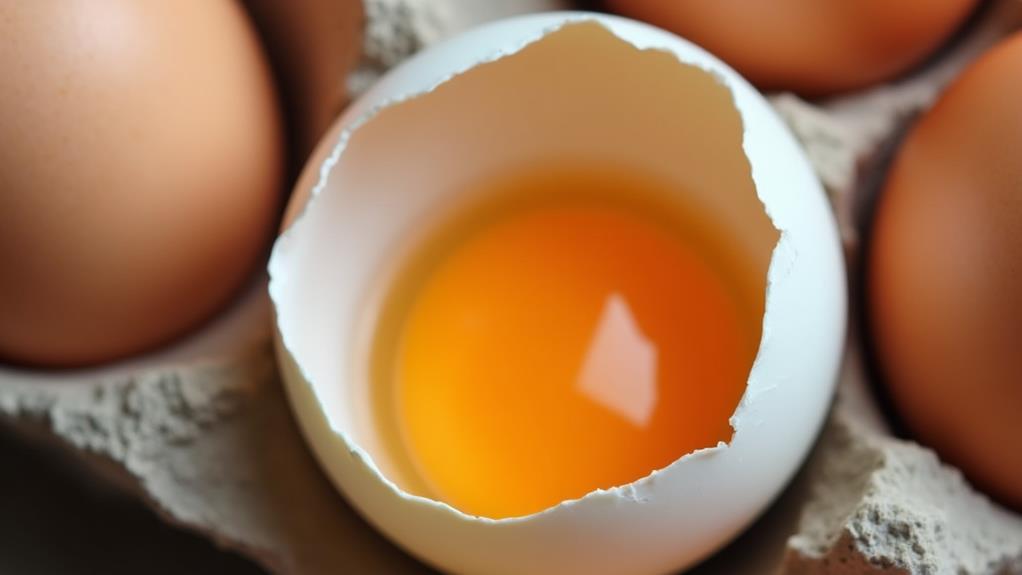
When it comes to poaching eggs, freshness is key, and you'll want to know how to identify the best eggs for your dish.
You can test an egg's freshness by gently placing it in a bowl of water; if it sinks and lies flat, it's fresh, but if it floats, it's past its prime.
While farm-fresh eggs are often touted as superior, store-bought eggs can be just as good if you choose wisely and store them properly in the refrigerator, keeping them away from strong odors and maintaining a consistent temperature.
Egg Freshness Test Methods
To ensure your poached eggs turn out perfectly, selecting the freshest eggs is crucial. Egg quality and freshness indicators play a vital role in achieving that restaurant-worthy poached egg.
You'll want to employ innovative techniques to assess the eggs' freshness before cracking them open. One reliable method is the float test. Fill a bowl with cold water and gently place the egg inside. If it sinks and lies flat on its side, it's fresh. An egg that stands upright on the bottom is still usable but not as fresh. If it floats, it's past its prime and should be discarded.
Another approach is the shake test. Hold the egg up to your ear and give it a gentle shake. A fresh egg will have minimal movement inside, while an older egg will produce a sloshing sound due to the air pocket inside growing larger over time.
Here are three additional freshness indicators to consider:
- Date on the carton
- Appearance of the shell (smooth and clean)
- Consistency of the egg white when cracked (firmer indicates freshness)
Farm-Fresh vs. Store-Bought
In the realm of egg selection, farm-fresh and store-bought eggs often compete for the title of freshest option. When it comes to poaching, freshness is crucial, and understanding the differences between these sources can elevate your culinary experience.
Farm-fresh eggs offer unparalleled benefits, including vibrant yolks, firmer whites, and enhanced flavor profiles. These eggs typically come from smaller, local farms where hens enjoy diverse diets and better living conditions.
You'll notice a marked difference in taste and texture, making them ideal for poaching. However, sourcing farm-fresh eggs may require extra effort and planning.
On the other hand, store-bought eggs provide convenience and consistency. While they may not match the freshness of farm eggs, many supermarkets now offer high-quality options from reputable suppliers.
Look for eggs with the latest possible expiration date and check for any USDA certifications. To maximize freshness, store eggs in their carton and use them within two weeks of purchase.
Ultimately, your choice depends on your priorities. If you're seeking the pinnacle of freshness and flavor, farm-fresh eggs are worth the effort. For everyday cooking, store-bought eggs can still yield excellent results when selected and stored properly.
Ideal Egg Storage Conditions
The humble refrigerator plays a starring role in preserving egg freshness. By maintaining a consistent egg temperature, you'll ensure your poaching ingredients remain in peak condition. Aim for a cool 40°F (4°C) to slow bacterial growth and maintain quality.
But don't stop there – ideal humidity levels are equally crucial. Too dry, and your eggs may lose moisture; too humid, and you risk condensation, which can promote bacterial growth.
To optimize your egg storage:
- Keep eggs in their original carton to protect them from absorbing odors
- Store them on an interior shelf, not the door, for more stable temperatures
- Arrange eggs with the pointed end down to keep yolks centered
Innovate your storage approach by investing in a smart refrigerator with precise temperature and humidity controls. These cutting-edge appliances can maintain the perfect environment for your eggs, ensuring they're always ready for that perfect poach.
Mastering the Swirling Technique
Creating a perfect vortex in your poaching water is key to achieving beautifully shaped poached eggs. To master this crucial step, you'll need to refine your swirling techniques and create an egg whirlpool that's just right.
Start by filling a deep saucepan with about 4 inches of water and bringing it to a gentle simmer. Add a splash of vinegar to help the egg whites coagulate faster.
Now, grab a long-handled spoon and stir the water in a circular motion to create a steady whirlpool. The trick is to find the sweet spot between too slow and too fast; aim for a vortex that's strong enough to wrap the egg white around the yolk but not so violent that it tears the delicate protein structure.
Once you've established the perfect swirl, carefully crack your egg into a small bowl. Lower the bowl close to the water's surface and gently slide the egg into the center of the vortex. The swirling motion will help the egg white envelop the yolk, resulting in a perfectly poached egg with a compact, attractive shape.
The Vinegar Secret Revealed
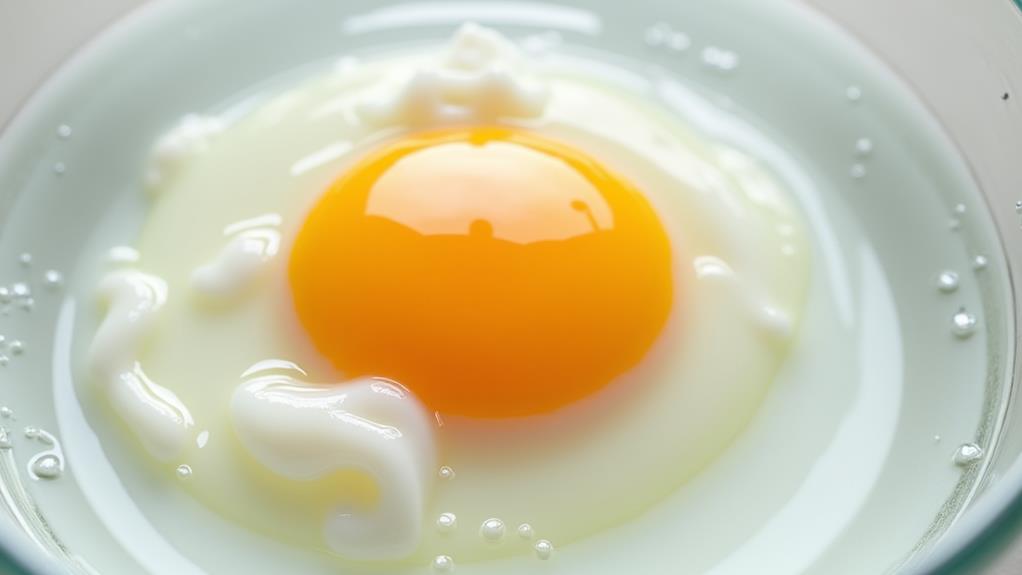
Occasionally debated among culinary enthusiasts, vinegar's role in poaching eggs is often misunderstood.
Let's unravel this culinary mystery and explore how vinegar can elevate your poached egg game. The secret lies in vinegar's ability to accelerate protein coagulation, resulting in tighter, neater egg whites.
When it comes to vinegar types and poaching ratios, you've got options. While white vinegar is the classic choice, you can experiment with:
- Apple cider vinegar for a subtle fruity note
- Rice vinegar for a milder tang
- Champagne vinegar for a touch of elegance
The ideal poaching ratio is about 1 tablespoon of vinegar per cup of water. This balance ensures the eggs hold their shape without imparting an overpowering acidic taste.
As you pour the vinegar into the simmering water, you'll notice tiny bubbles forming – that's the acid at work, creating the perfect environment for your eggs.
Timing Is Everything
Poaching's success hinges on precise timing. To achieve that perfectly runny yolk encased in a silky white, you'll need to master the delicate balance between poaching temperature and cooking duration.
Start by bringing your water to a gentle simmer, around 180-190°F (82-88°C). This temperature range ensures your eggs cook evenly without becoming rubbery.
Once you've added your egg to the water, set a timer for 3 minutes. This is the sweet spot for most poached egg enthusiasts, but feel free to adjust based on your preferences. If you like a firmer yolk, add 30 seconds; for a more liquid center, subtract 30 seconds.
Remember, the size of your egg will also impact cooking time, so you may need to experiment to find your ideal duration.
As you become more adept at poaching, you'll develop an intuitive sense of doneness. Look for whites that are set but still tender, and a yolk that jiggles slightly when you gently prod the egg.
With practice, you'll soon be crafting perfectly poached eggs with confidence and precision.
Troubleshooting Common Poaching Problems
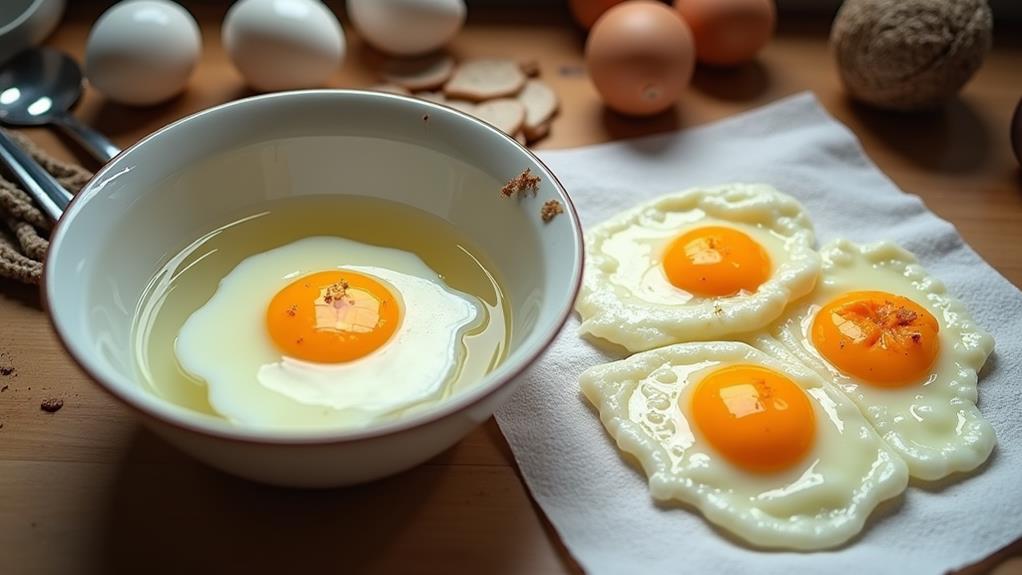
Despite your best efforts, you may encounter some hiccups when poaching eggs. Common issues include egg whites spreading too thin or yolks breaking prematurely. To combat these challenges, focus on temperature control and egg white consistency. Start by ensuring your water is at a gentle simmer, not a rolling boil. This creates the ideal environment for the egg to cook evenly without disruption.
For optimal results, consider these innovative techniques:
- Use a fine-mesh strainer to remove excess watery whites before poaching
- Add a splash of vinegar to the water to help egg whites coagulate faster
- Create a vortex in the water before adding the egg to encourage a compact shape
If your poached eggs still aren't perfect, don't despair. Practice makes perfect, and each attempt brings you closer to mastery.
Pay attention to the freshness of your eggs, as fresher eggs tend to hold their shape better during poaching. Additionally, experiment with different water temperatures and poaching times to find the sweet spot for your preferred level of doneness.
Elevating Your Poached Egg Dishes
Now that you've mastered the art of poaching eggs, it's time to elevate your culinary creations. Your perfectly poached eggs can become the star of countless innovative dishes, transforming your meals from ordinary to extraordinary.
Start by exploring creative toppings that complement the delicate texture of poached eggs. Consider adding a sprinkle of smoked paprika, a dollop of pesto, or a drizzle of truffle oil to enhance the flavor profile.
Next, experiment with unique flavor pairings to create memorable combinations. Try serving your poached eggs atop a bed of sautéed kale and mushrooms, or nestled in a bowl of creamy polenta with roasted cherry tomatoes.
For a more daring approach, pair your eggs with unconventional ingredients like kimchi or pickled vegetables to add a tangy kick.
Don't limit yourself to breakfast dishes; poached eggs can elevate lunch and dinner too. Incorporate them into grain bowls, salads, or even pizzas for added protein and richness.
Exploring Global Poached Egg Recipes
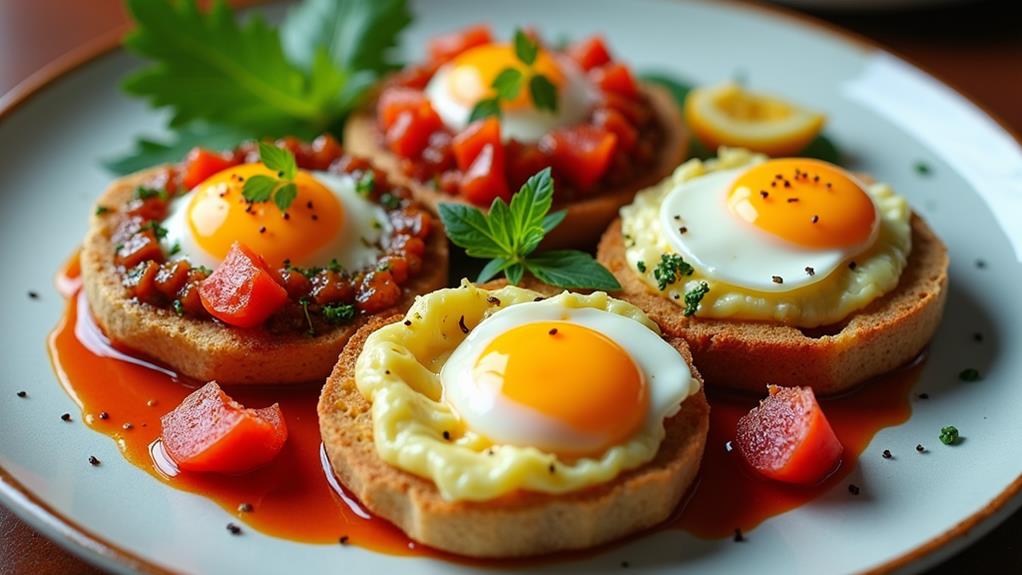
Poached eggs have found their way into countless global cuisines, each offering unique and delicious interpretations. As you explore these international flavors, you'll discover how this simple cooking method has been embraced and enhanced worldwide.
Mediterranean variations often incorporate olive oil, fresh herbs, and tangy feta cheese, while Asian influences might feature soy sauce, sesame oil, or fragrant spices like ginger and turmeric.
Breakfast traditions and brunch innovations across the globe have elevated poached eggs to new heights. You'll find them nestled atop avocado toast in trendy cafes, swimming in spicy tomato sauce in Middle Eastern shakshuka, or crowning a steaming bowl of Vietnamese pho.
To truly appreciate the versatility of poached eggs, consider experimenting with these gourmet toppings and regional spices:
- Dukkah: An Egyptian nut and spice blend
- Furikake: A Japanese seasoning with seaweed and sesame
- Za'atar: A Middle Eastern herb and spice mixture
Beyond their culinary appeal, poached eggs offer significant health benefits. They're a protein-rich, low-calorie option that's easily digestible.
Frequently Asked Questions
Can I Poach Eggs in Advance and Reheat Them Later?
Yes, you can poach eggs in advance! Enhance your culinary game by mastering innovative poaching techniques. When you're ready to serve, try cutting-edge reheating methods like sous vide or a gentle warm water bath for perfectly reheated poached eggs.
Are There Any Health Benefits Specific to Eating Poached Eggs?
You'll be over the moon with poached eggs' protein benefits! They're a nutritional powerhouse, packed with essential nutrients. This innovative cooking technique preserves more nutrients than other methods, giving you a healthier, cutting-edge breakfast option.
How Do Different Egg Sizes Affect Poaching Time and Technique?
You'll find that egg size impacts poaching time and technique. Larger eggs need longer cooking, while smaller ones require less. Adjust your approach accordingly, experimenting with different sizes to perfect your innovative poaching methods.
Can I Use Egg Substitutes or Liquid Eggs for Poaching?
You can experiment with egg substitute options for poaching, but results may vary. Liquid egg techniques work best when you're seeking innovation. Try plant-based alternatives or specialized liquid eggs designed for poaching to push culinary boundaries.
What's the Best Way to Store Leftover Poached Eggs?
Don't let your poached perfection go to waste! You'll crack the code of egg storage by placing your creations in ice-cold water. Once chilled, store them in an airtight container. Reheat gently for innovative poaching tips.
Final Thoughts
You've now mastered the art of poaching eggs, congratulations! You're ready to amaze your friends with perfectly runny yolks and silky whites. But don't stop here; why not challenge yourself to poach an ostrich egg next? It's only slightly larger than a chicken egg, after all. As you embark on this new culinary adventure, remember: if at first you don't succeed, there's always scrambled eggs. Now go forth and poach with confidence!

